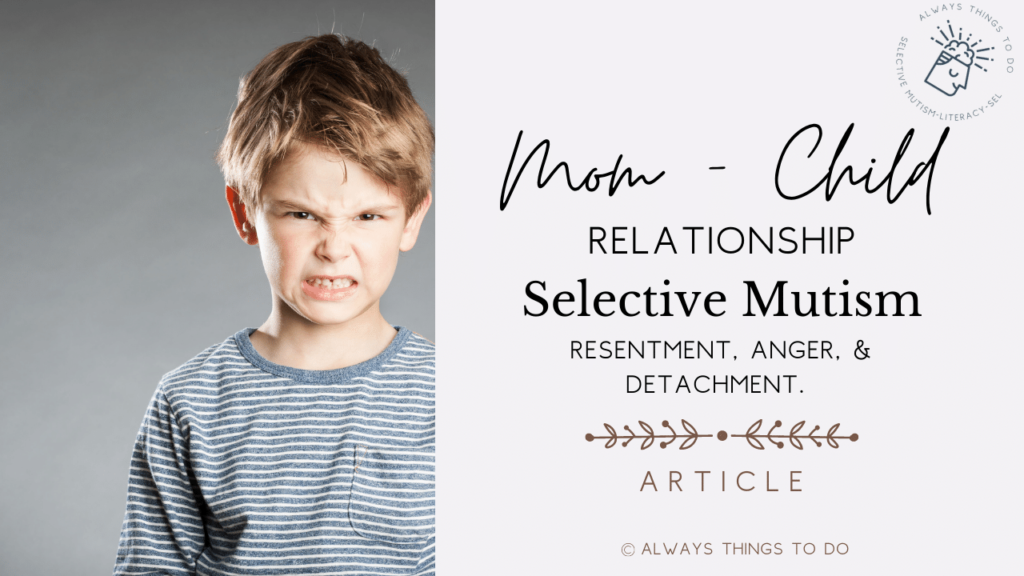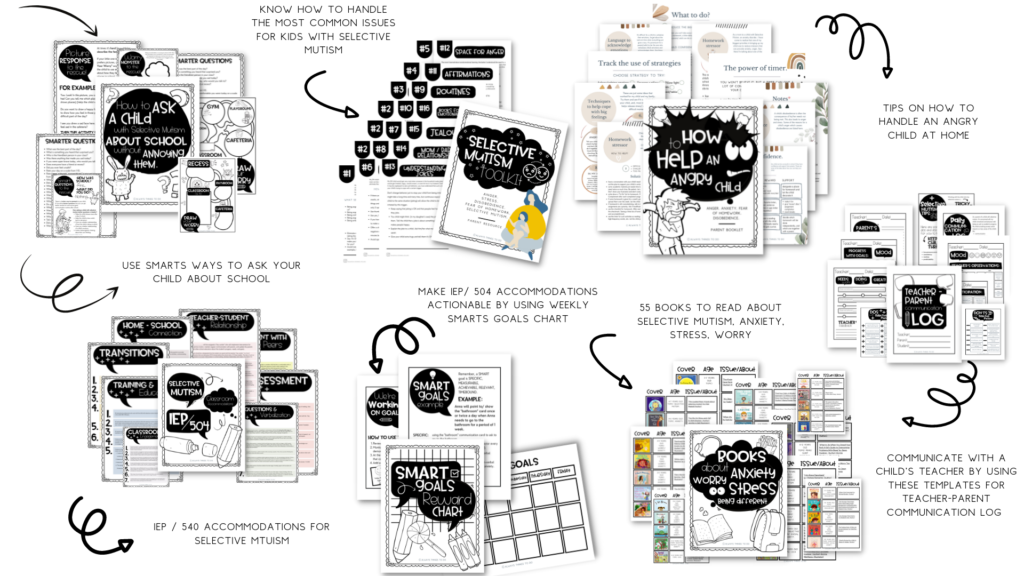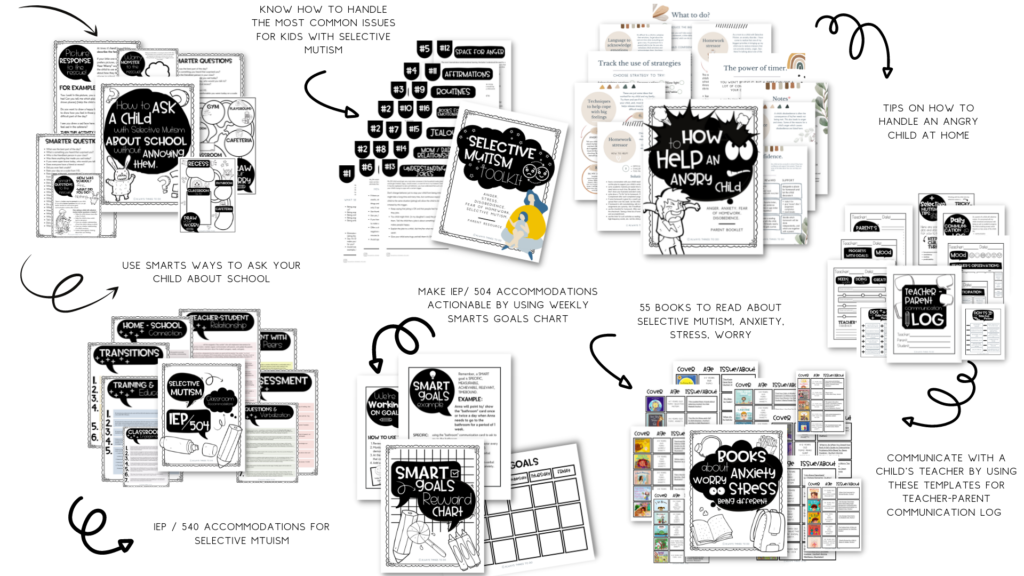Helping a Child With Selective Mutism Through Big Emotions: Mom/Parent-Child Relationship, Resentment, Anger, and Detachment.

If you don’t believe in mental health, neuropsychology ( how a person’s nervous system and brain influence their cognition and behavior), nor do you believe your child’s journey with selective mutism has to include your own mental health, my advice is to close this window immediately or just move on.
If you are still hanging there, it means you may be desperate or ready for anything to understand how the selective mutism journey can no longer be a burden but a transformative path to get to the mental health issues.
So, continue reading because you will get 6 insights into how you can help your child with selective mutism through big emotions and how you can repair your mom-child relationship if it seems to be nothing but anger, resentment, even hatred.
Explore “Selective Mutism Home-School Parent Toolkit” with the collection of resources to help you with:
- identifying the right school accommodation
- finding books about selective mutism and anxiety
- handling anger with your child
- addressing most common issues with selective mutism, and more. ⬇️ ⬇️ ⬇️

1. Your child with selective mutism mirrors your anxiety/ emotional state.
When the selective mutism diagnosis of my daughter became part of our lives, I threw myself in a very dark place where self-blaming, fear, and frustration accompanied me in everyday activities.
The more irritable, exhausted, nervous, overwhelmed I felt, the worse symptoms and behaviors my daughter displayed.
One day she asked, “Are you mad because of me?”
Tracking your mood and emotional state, in general, is a good way to see the pattern that can show whether your emotional state adds to or triggers your child’s higher levels of anxiety.
A child with selective mutism (I learned it from my daughter) is extremely sensitive to the environment and the moods of others.
Simply saying, the chaos outside of the child will trigger more irritability, anger, moodiness, defiance and screaming, especially if the child senses a parent’s anger, fear, resentment, or tiredness.
What helped me and my daughter in fixing and normalizing our relationship is a few things:
- As a mom, I was convinced that my mood would trigger my child’s anxiety, so my advice to you is to start monitoring your emotional states.
- When you feel strong emotions (frustration, sadness, anger, etc.), explain it to your child so that she/he does not attribute your moods to what’s happening to the child.
- Start learning about meditation/metal relaxation techniques/ anything that can work for you and make sure you are rested emotionally to be able to be there when your child has strong feelings or displays behavior that need your full attention (hitting, screaming, etc. you name it).
- Stop connecting selective mutism to parenting failures and start seeing selective mutism as related to anxiety; therefore, any behaviors that may seem to be due to misbehavior or defiance (hitting, screaming, refusal, procrastination) have to be viewed as manifestations of anxiety a child does not know how to handle.
2. Hitting, being mad at a parent is not hate or resentment. This may be the way for a child with selective mutism to seek help and attention.
In my 3 years of being a mom of a child with selective mutism, I’ve learned to see any hitting or feeling mad at a parent as signs that my child needs my attention and help.
The reasons for such behavior (hitting, being extremely mad, defiant, etc.) can be different: boredom, jealousy, inability to cope with big feelings, a try to bring parent’s attention, loneliness, etc.
The severity of this behavior can vary depending on where the child is on the journey with selective mutism.
When anxiety level is still very high and the child is non-verbal in most social settings, behaviors like hitting, anger, resentment may appear more often and be lengthier.
However, if a child is already making a lot of progress with speaking and/or takes medication for anxiety, such behaviors may happen too even though less frequently.
These are some tips to handle such behavior:
- Acknowledge child’s emotions and verbalize them: “ I see you are angry/ irritated. It’s OK to feel angry/ irritated.”
- Suggest something for a child to do: “Do you want to watch a cartoon with me or color?”
- If the child needs some time to get over big emotions, be aware of it, but offer an immediate support: “Do you want a hug from mommy or do you want a hug from your teddy bear?”
- If you have emotion regulation techniques you follow with you child, use them (ex.: squeezing a pillow, screaming into the pillow, breathing in and out, stomping, etc.)
Read “Selective Mutism Tantrums: How to Deal With a Ball of Anger After School” to learn more ideas about how to handle anger.
3. Addressing emotional war of a child with selective mutism at home starts with a parent taking care of their emotional and physical needs.
A child with selective mutism may not have mechanisms for coping with big emotions or reactions to the numerous stimuli in the environment a child is anxious about. Without those mechanisms, a child’s reaction will be limited to extreme moodiness, screaming, maybe hitting, crying nagging, resentment, and anger.
The inability to express emotions for a child is quite natural.The inability for a parent to meet these big emotions and react to them appropriately can be detrimental to a child with selective mutism.
My own exhaustion as a mom and a teacher once brought me to severe anxiety and overwhelm. I knew little about teaching my child emotional regulation, nor was I able to meet the emotional needs of my daughter during tantrums and after-school transitions.
Anxiety that I felt at home would reflect in my child and she would be even more rebellious, unhappy, resentful, and angry.
Many things changed when I understood and started practicing this, and I urge you to do the same:
- If you don’t want to spike your child’s anxiety, regulate your own emotions.
- Take care of your mental health in a way that is sustainable to you.
- Take time to meet your emotional end physical needs. A rested parent can handle child’s big emotions more efficiently.
Your emotional health can make dramatic changes in your child’s mood and reactions. You will feel to be calmer, more reserved, a better-prepared parent.
4. A child with selective mutism needs portioned, strategic quality time with a parent.
More than learning to regulate emotions, a child with selective mutism needs continuous reassurance that he/she is loved, needed, special, cared for no matter what happens.
One of the common issues for a child with selective mutism is their low self-esteem, low confidence level, fear not to be heard or understood, loneliness, depressive mood. These issues can contribute to tantrums and sudden mood swings that I used to see a lot in my daughter.
To address that, I started planning a portioned, strategic quality time with my daughter.
Because like you, I’m a busy parent, I wanted to make sure I always connect to my child every day, and you can do the same with your child with these simple tips:
- Plan (a child with selective mutism loves to plan) with your child for the fun activity that will be timed (10-15 minutes). During this time there should be no other siblings or social media, just you and your son/daughter.
- Let the child set the timer.
- During the bonding time, do what your child chooses (watching a cartoon together, playing toys, dolls, coloring, etc.). Keep talking to your child, ask questions, and give compliments: “You are so observant! How did you notice that detail? / Your drawing is so detailed and the colors are amazing! / If you were….(cartoon character), would you follow the witch into the forest or wait until the sun comes out? Etc.)
- At the end of the time, say, “It was so much fun to hang out! Can we do it again tomorrow? Would you like to play dolls or do a puzzle?”
In my family, this strategically planned time worked perfectly.
5. A parent of a child with selective mutism needs to drop high expectations and unnecessary comparing.
I get it.
A desire to help your child immediately is a great desire.
Besides, selective mutism is overwhelming for the whole family. When issues with school, playgrounds, birthday parties, and communication with relatives appear, it will be very difficult not to want to fix everything right away.
The same is true for school-related issues. If your child is still non-verbal and experiences high levels of anxiety with accompanying problems (using the toilet, using gestures, belonging to the group, etc.), your desire to fix school issues is even stronger.
The problem with high expectation and “fixing” selective mutism before the school or the next birthday party start is that it will eventually drive you to disillusionment and exhaustion. Your child will sense your anxiety and fear. It will translate into more tantrums and more anxiety.
Comparing your child in terms of where he/she should be in social and academic life will not give you any good return or peace of mind.
My advice is to drop grade-related and society-related expectations of what and how your child should do and behave.
With therapy and whatever path you will choose in treating selective mutism, your child will follow a slow and steady route.
Changes will come slowly.
Support your child on every step. Don’t compare.
Read “6 Things You Can Do Right Now To Help Your Child With Selective Mutism” for advice about how to handle doubting thoughts and overwhelm.
6. A parent of a child with selective mutism needs to take a long-term approach with handling selective mutism.
My daughter was 4 when she was diagnosed with selective mutism. She is 7 now.
If someone told me it would take us three years to find some sort of ‘normalcy’ in life, I would be horrified.
The reality with selective mutism is that it may take 2 or 3 or 5 or 7 years to get to the point you want your child to be. And still, at that point, you will ask yourself if there is something else to do.
Addressing anxiety, tantrums, emotional swings, moodiness, sensitivity and many other issues related to selective mutism should start today and should continue tomorrow and the day after that.
Continuous and steady progress in emotion regulation, figuring out schooling, special education support, family dynamics, exhaustion management will produce results sooner or later.
For us, it took solid 3 years to breathe out and let selective mutism be in the background for now.
These three years were emotional, exhausting, and hard, but this was also the time when I learned a lot about handling selective mutism, school-related issues, and teaching my child to navigate big feelings, self-doubt, tantrums, moods swings, jealousy, hitting, and screaming.
The bottom line, invest daily into doing something about selective mutism: educate yourself and your child’s teachers, teach your child emotion regulation, learn to take care of your own emotional state, find opportunities for your child to express themselves without speaking, find support at school and the right accommodations that will serve your child at school.
Is the road easy? No, it’s not.
But it’s doable 100%.
Check out the “Selective Mutism Home-School Parent Toolkit” with the collection of resources to help you with identifying the right school accommodation, finding books about selective mutism and anxiety, handling anger with your child, addressing most common issues with selective mutism, and more. ⬇️ ⬇️ ⬇️

If you liked the information in this post, make sure you explore other posts about selective mutism:
- 7 Must-Do Things For A Parent of A Child With Selective Mutism: Actionable Tips and Resources to Consider.
- 6 Things You Can Do Right Now To Help Your Child With Selective Mutism.
- Selective Mutism Tantrums: How to Deal With a Ball of Anger After School.
- “What Is Selective Mutism?”
- “Selective Mutism: How To Beat Crisis, Screaming, and Fear.”
- Diagnosis of Selective Mutism: Simple Parent Guide and Steps to Take.
- What Are The Causes of Selective Mutism?
- Is Selective Mutism a Disability?
- How Do You Treat Selective Mutism?
- 70 Selective Mutsim Symptoms & 3 Diagnostic Criteria.
- Selective Mutism Myths: Most Common Concerns Addressed.
- Selective Mutism Classroom Accommodations: What You Need To Know About 504 and IEP.
Check out the expanding library of tools. Go to the selective mutism page and scroll to the bottom section, “Latest Projects.”
Connect with me on social media @alwaysthingstodo.

